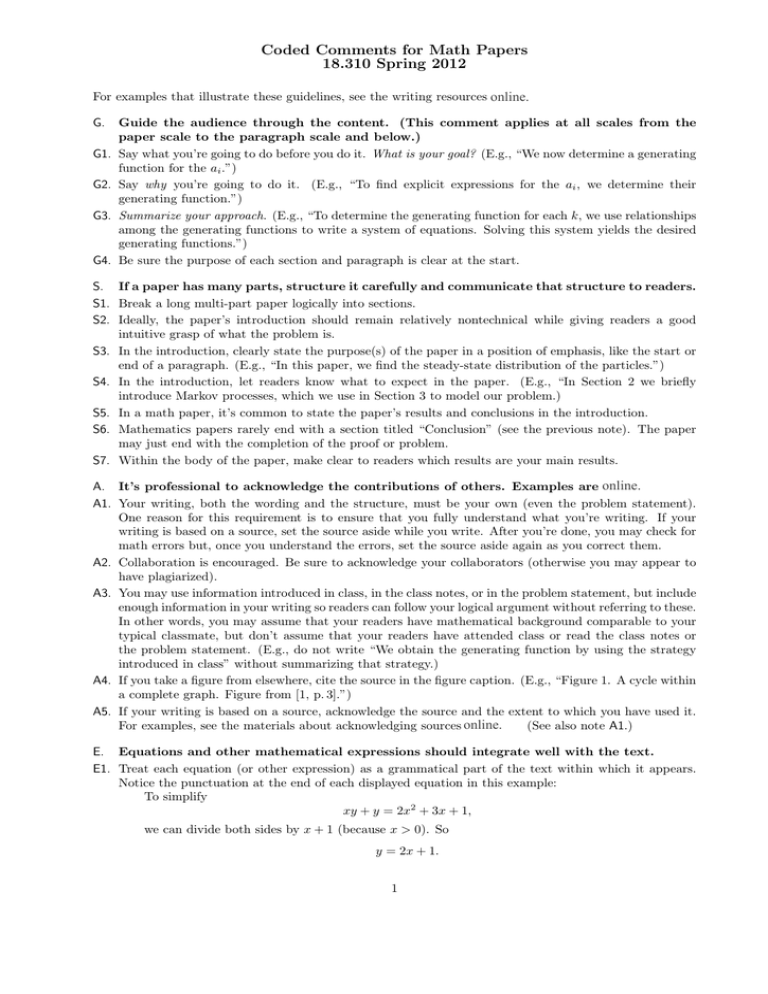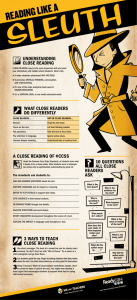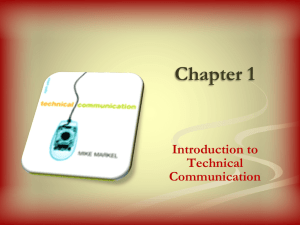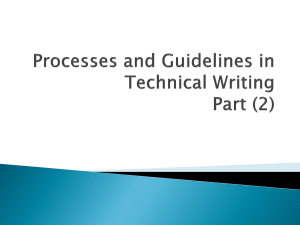Comments for Math Papers Coded Spring 2012 18.310
advertisement

Coded Comments for Math Papers
18.310 Spring 2012
For examples that illustrate these guidelines, see the writing resources online.
G. Guide the audience through the content. (This comment applies at all scales from the
paper scale to the paragraph scale and below.)
G1. Say what you’re going to do before you do it. What is your goal? (E.g., “We now determine a generating
function for the ai .”)
G2. Say why you’re going to do it. (E.g., “To find explicit expressions for the ai , we determine their
generating function.”)
G3. Summarize your approach. (E.g., “To determine the generating function for each k, we use relationships
among the generating functions to write a system of equations. Solving this system yields the desired
generating functions.”)
G4. Be sure the purpose of each section and paragraph is clear at the start.
S. If a paper has many parts, structure it carefully and communicate that structure to readers.
S1. Break a long multi-part paper logically into sections.
S2. Ideally, the paper’s introduction should remain relatively nontechnical while giving readers a good
intuitive grasp of what the problem is.
S3. In the introduction, clearly state the purpose(s) of the paper in a position of emphasis, like the start or
end of a paragraph. (E.g., “In this paper, we find the steady-state distribution of the particles.”)
S4. In the introduction, let readers know what to expect in the paper. (E.g., “In Section 2 we briefly
introduce Markov processes, which we use in Section 3 to model our problem.)
S5. In a math paper, it’s common to state the paper’s results and conclusions in the introduction.
S6. Mathematics papers rarely end with a section titled “Conclusion” (see the previous note). The paper
may just end with the completion of the proof or problem.
S7. Within the body of the paper, make clear to readers which results are your main results.
A. It’s professional to acknowledge the contributions of others. Examples are online.
A1. Your writing, both the wording and the structure, must be your own (even the problem statement).
One reason for this requirement is to ensure that you fully understand what you’re writing. If your
writing is based on a source, set the source aside while you write. After you’re done, you may check for
math errors but, once you understand the errors, set the source aside again as you correct them.
A2. Collaboration is encouraged. Be sure to acknowledge your collaborators (otherwise you may appear to
have plagiarized).
A3. You may use information introduced in class, in the class notes, or in the problem statement, but include
enough information in your writing so readers can follow your logical argument without referring to these.
In other words, you may assume that your readers have mathematical background comparable to your
typical classmate, but don’t assume that your readers have attended class or read the class notes or
the problem statement. (E.g., do not write “We obtain the generating function by using the strategy
introduced in class” without summarizing that strategy.)
A4. If you take a figure from elsewhere, cite the source in the figure caption. (E.g., “Figure 1. A cycle within
a complete graph. Figure from [1, p. 3].”)
A5. If your writing is based on a source, acknowledge the source and the extent to which you have used it.
For examples, see the materials about acknowledging sources online.
(See also note A1.)
E. Equations and other mathematical expressions should integrate well with the text.
E1. Treat each equation (or other expression) as a grammatical part of the text within which it appears.
Notice the punctuation at the end of each displayed equation in this example:
To simplify
xy + y = 2x2 + 3x + 1,
we can divide both sides by x + 1 (because x > 0). So
y = 2x + 1.
1
E2. When deciding whether to use words or notation, ask which would be easier for readers. (E.g., “There
are more than 3 edges” is easier to read than “If n is the number of edges, then n > 3.” In contrast,
“7 − n > 3” is easier to read than “n less than seven is more than three.”)
E3. Be precise. Definitions and theorems should be clear and correct. You may use looser language when
motivating a definition or result, but statements and proofs must be mathematically precise.
E4. To make the paper easy to read, “display” math by centering each expression on a line by itself (as in
the example in note E1). Display math if it’s long, if it’s important, if you need to refer back to it, if
readers need to be able to compare lines, if, left within the text, the equation would break across the
end of a line or if it would stick into the right margin, or if displaying it would simply make the paper
easier to read. (Often, simply rewording improves the situation.)
E5. Displayed math should usually be interspersed with text explaining how each line relates to the preceding
lines, as in the example in note E1. If you have many equations with nothing between them, add
explanations or ask yourself whether you’re showing too many details. (The example in note E1 does
not show the division by x + 1, but is still sufficiently clear for an audience of peers.)
E6. Number displays so you can refer to them later in the paper, but number only those to which you do
refer. (If you’re using LATEX, search online for “LATEX suppress equation number.”)
P. Leave time to set the paper aside for a while, reread, revise, and repeat (as many times
as needed). After the content is correct and clearly presented, polish the paper.
P1. Check your paper’s structure by writing the main point of each paragraph in the margin to create an
outline. Revise to create a more logical structure and/or to communicate the structure to readers.
P2. Check that all variables are introduced and are used consistently.
P3. Don’t start a sentence with a symbol: it’s easier to read sentences that start with a capitalized word.
Similarly, don’t run math expressions together; separate them with words, not commas.
P4. Don’t use mathematical symbols as shorthand in text (e.g., do not write “The number of edges is > x”);
however, it is acceptable to include complete expressions in text (e.g., Because x < 3, . . . ).
P5. Make a personalized editing checklist for yourself. Include those things you often forget to do.
P6. Use a spell checker. Many LaTeX editors have a spell checker that ignores TeX code; if yours doesn’t,
you can strip the TeX code by copying from the pdf into a program that has a spell checker.
P7. Have a classmate or someone else read over your draft, checking for grammatical errors, convoluted
sentences, confusing explanations, etc. Return the favor, and acknowledge your collaborator.
P8. Print the paper to do a final proofreading: you’ll catch errors on paper that you’d miss on screen.
L. To learn how to do something in LaTeX, search online and skim to find a good response.
L1. To create curly quotes like the ones on the left side of “this, type two single left quotes. The single left
quote ‘ may be just left of the 1 on your keyboard.
L2. Indent only when you intend to start a new paragraph. To remove an indent after a displayed equation,
remove the blank line from the tex code.
L3. If you’re looking for a particular symbol, search online for “latex symbols.” The Detexify website allows
looking up symbols by drawing them, http://detexify.kirelabs.org/classify.html.
L4. To start a new paragraph, add a blank line to the tex. To add space between paragraphs, use
\smallskip, \medskip, \bigskip, \vspace{\baselineskip}, or a finer measure, e.g., \vspace{4pt}.
T. If you use concepts that are new to your readers, design the paper to help the readers
build understanding.
T1. Add examples or illustrations whenever you can. A paper littered with examples is often easier to read.
Make sure the examples illustrate as many of the subtleties of the definition or theorem as possible.
Nonexamples are sometimes just as useful. (E.g., a planar graph K4 and the nonplanar graph K5 ).
T2. Plan and write from the theorems out. In other words, write down the theorems you plan to prove,
then list what examples you need to help readers understand the theorem and what supporting lemmas
you need to make the proof easier. Then list the definitions you need. Then list the examples you need
to help readers understand the definitions.
2
MIT OpenCourseWare
http://ocw.mit.edu
18.310 Principles of Discrete Applied Mathematics
Fall 2013
For information about citing these materials or our Terms of Use, visit: http://ocw.mit.edu/terms.





